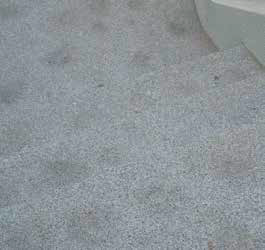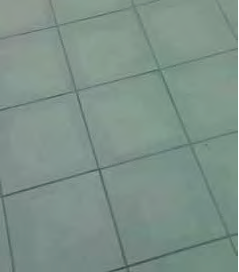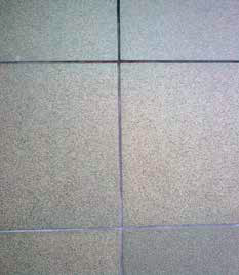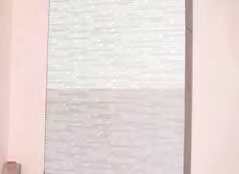- Products
- Systems
- Tools & Services
News
Discolouration of tiles – defect under investigation
Discolouration of tiles and joints can destroy the visual effect of the most painstaking works. Some types of tiles, for example those made of natural stone, may be particularly vulnerable to discolouration. How one can avoid this process? Firstly, we need to know the factors which cause discolouration. Let’s take a look at them by investigating some examples.
Case 1. A tiler observed point discolouration of natural stone tiles.
Defect
The photo and the invoice for the purchased adhesive clearly showed that the adhesive based on grey cement was used there. The grey cement was responsible for the point discoluration of tiles.
Diagnosis
During the analysis of this problem, the dark spots yet showed one more tiler’s mistake – the tiles were bonded with a point method. The basic principle in case of installing tiles outdoors, namely applying the adhesive upon the entire surface which the tile is to be bonded, was not met. The cost of potential repair would be enormous. Still we do not know the investor’s decision whether the tiles have been removed or left as they were.
One needs to remember that stone tiles may be vulnerable to discolouration – in result of capillary action the moisture and dirt coming from the adhesive mass or even from the substrate can be transported to the upper surface of the tile.
Solution
If the contractor wants to minimize the risk of discolouration of sensitive tiles, one should use the adhesives based on white cement. In addition, one should keep the workplace and the materials clean at each work stage. Let’s mention one amusing but absolutely real situation to visualize it. Once there appeared yellow spots on the marble surface. It occurred that they were caused by cigarette butts which had been embedded in the adhesive by the installers!
The essential difference between grey and white cement is that grey one contains large amount of grey natural pigment and white cement contains very limited amount of it. The pigment in grey cement, e.g. in ATLAS Plus adhesive consists mostly of iron compounds and other colour oxides – particles easily transported in water solutions. The risk of discolouration of sensitive tiles increases in direct ratio to the amount of iron compounds and oxides in the mortar. Therefore, we should use the adhesives which contain the smallest amount of them – these are generally the adhesives based on white cement.
Case 2. A tiler observed discolouration of tiles edges caused by the grout.
Defect
When grouting and cleaning were completed, the contractor noticed that tiles were not cleaned completely. Neither chemical agents nor domestic detergents resolved the problem. Tiles were permanently discoloured.
It is a very often defect – it happens especially when the installation is done by unexperienced contractors.
Diagnosis
What could happen? The previous example showed us that highly absorbable tiles absorb pigment from mortars (by capillary action) and get permanently discoloured. Here, a fundamental mistake was made even before the beginning of works. Namely, the contractor did not do a test of tile discolouration by grout. Before he started grouting, he should have applied some grout on unused piece of tile so he could have seen the result. The effects of this test would allow him to choose the method of grouting and determine how fast he should clean dirt from the tiles. In case of negative test outcome, he would be given a chance to change the grout type completely.
Solution
Unfortunately, it is technically impossible to reverse this process and to remove the soiling. Frequent washing of surface with agents designed for cleaning the tiles can sometimes help. Nevertheless, much better solution is to avoid the potential problem at the beginning of work and to conduct appropriate test in advance. Despite that tiles of natural stone are those which are particularly vulnerable to this kind of phenomenon, it is recommended to do the test with any new tile type. The solution for the discussed case was to remove the entire cladding and to apply it all over again.
Case 3. The investor reported problem with the grout discolouration
Defect
One grout, one contractor, one technological cycle and the joint looks like in the photo. We can see that it looks very badly – its colour is non-homogenous.
Diagnosis
There may be several reasons for this defect. It is very rare to indicate only the most appropriate one. We will mention just a few of them. Please remember that not all of the following factors are necessarily associated with the case shown in the picture:
– uneven grout thickness (the adhesive between tiles was not removed on time),
– too much of batched water used for the grout preparation,
– the grout was not mixed carefully enough,
– bonding the tiles to the substrate which is permanently subjected to damp action,
– lack of proper care of grout during the process of binding,
– use of cleaning agents different than water immediately after grouting.
Solution
In this case, identifying the reason of defect is less important than determination of the possible repair. Let’s then go straight to the recommended solution. Obviously, the joints do not need to be removed. One needs only to repaint them. The repaint should be done with so-called grout renovators which are basically highly resistant to abrasion acrylic paints, e.g. ATLAS Fugero. The only potential problem is to find a renovator in the appropriate colour. Application of paint is not difficult, but certainly very tedious and time consuming.
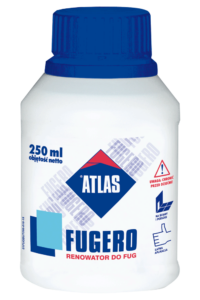 |
GROUT RENOVATOR Restores colour of cement and acrylic grouts – renovates and unifies colours of dis-coloured, dirty and faded grouts or ones with efflorescence. Repairs the grout between ceramic tiles (glazed, terracotta, gres-porcelain, clinker, china mosaic), stone and High coverage degree enables changing the colour of the grout, applies new colour irrespective of the colour intensity of the renovated grout. High abrasion resistance – can be used on floors in places exposed to intensive pedestrian traffic. 3 ready-to-use colours: white, light grey and light beige. Time of drying: approx. 2 hours. Very good bonding. Contains cellulose microfibres – they form the inner structure, provide very good coverage of the painted surface and |
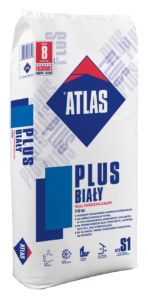 |
DEFORMABLE WHITE ADHESIVE (C2TE S1 TYPE) Contains white cement. Protects tiles vulnerable to discolouration resulting from contact with grey cement – e.g. glass mosaic and stone tiles. Deformable, highly flexible. For difficult substrates – OSB and plasterboard, terraces, heating systems. Universal application – for tiling: small, medium and large size tiles of high absorptiveness; stone, ceramic and cement tiles. Reduced slip –enables fixing tiles from top to bottom. |
Original text: Piotr Idzikowski, ATLAS Group
English text: Piotr Marciniak, ATLAS Group
